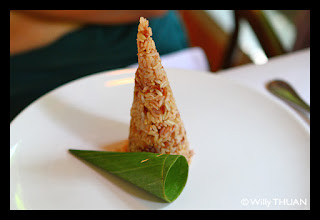Lots of restaurants are pitching for their "Royal Cuisine" these days with the design, staff outfit, food presentation and menu. Many of them are just another tourist trap. Well, what do commoners like me know? We read of course. There are plenty of books written by people who served the royal families in the old time, in various topics from the life in palace to recipe and domestic management... giving us some clues. So, in short, what is Royal Cuisine?
We call these food A-harn Chao Wang, meaning food for people living in the palace. Here are some of the few key characteristics of the A-harn Chao Wang based on my reading:
Food is served in set or Sum-rub (สำรับ) with variety of dishes having different tastes, texture, colours, kinds and ways of cooking. We call each of those individual dishes Kub Kao, meaning a dish to eat with rice, there is no equivalent word for this in English. The portion of each Kub Kao is quite small. Variety seems to be the key. Samples of different Sum-rub to give you some ideas below:
- Clear Soup (Gang Jued) + Fried Chicken + Pork Curry + Stir-fried Kale with Oyster Sauce + Chili Paste Northern Style (Nam Prik Ong) + Pork Salad in Esan style (Laab Moo) + Lychee in syrum for dessert.
- Chicken Massaman + Stir-fried Crab with Curry Powder + Mushroom Salad + Chili Paste with Fresh Vegetables (Nam Prik) + Braised Beef + Pan-fried Fish + Sago and Black Beans for dessert.
- Beef Green Curry + Crab Meat Dip (Lon Poo) with Fresh Vegetables + Stuffed Crab (Poo Jha) + Stir-fried Pork with Satled Egg + Sausage Salad + Stir-fried Liver with Sweet Chili + Fresh Fruits for dessert.
The dishes are prepared to please the eye and the palate always, with a lot of attention to details
As convenient to eat as possible: vegetables cut into bite size so you won't have to cut them again on your plate, the prawn head removed, the long vegetables tied into a knot (therefore no cutting on your plate is required) etc. A book written by a royal chef, who cooked for princes and princesses, mentioned that the whole fish was served boneless... not fillet but someone spent time removing bones from the whole fish!
The rule of thumb is that everything on the plate must be edible.
Not necessary sweet. There has been misconception that the royal food will have to be sweet. This is not true.
Not too spicy. The taste in a dish will blend smoothly but not be bland.... no taste will spike.
The cooking will follow the original recipe exactly - there is no room for fusion here if the dish is claimed to be royal.
The following pretty and yummy dishes seem to be quite common in the restaurants that claim to be royal or traditional. Many of them are "old" food that is not easy to find anymore because it is not easy to make them at home, unless you have all day and a troop of helpers like they do in the royal kitchen -- yep according to the book the royal cooking team is huuuge.
- Purple Dumpling - Cho Muang (ช่อม่วง)
- Tawai Vegetables Salad - Yam Tawai (ยำทวาย)
- Kra-tong Thong กระทงทอง
- Mee Grob
- Summer Rice - Kao Chae (ข้าวแช่), which is a cooked rice served in fragrant, ice water... accompanied with 4-5 deep fried Kub Kao like
- Egg Sausage Soup - Gang Jued Look Rok (แกงจืดลูกรอก)
But again, it is not about which dishes are being royal and which are not. All those Thai dishes we have every day could actually be royal, depending on its recipe and how they are prepared.
Now, where? One place can really give you the thrill is Thanying Restaurant in Pramuan Road, in Silom ~ Sathorn area. If you are in Phuket, the closest you can find is probably the Blue Elephant in Phuket Town.
Last but not least, there are actually plenty of restaurants that never pitch on their royal-ness, but do serve authentic Thai food following Chao Wang recipe. |
_ |
 |
| Mee Grob |
 |
| Coconut Milk Ice Cream |
 |
| Nam Prik |
 |
| Poo Jha |
 |
| Rice, with Bai Sri cone |
 |
| Mixed Appetizers |
|








